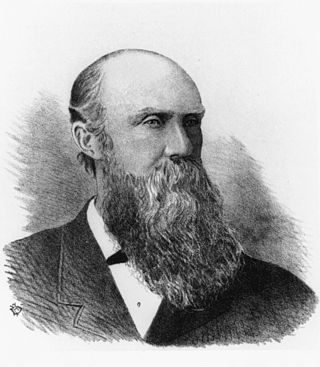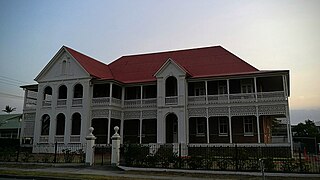
Richard Gailey, Sr. was an Irish-born Australian architect.

Breakfast Creek Hotel is a heritage-listed hotel at 2 Kingsford Smith Drive, Albion, City of Brisbane, Queensland, Australia. It was designed by Simkin & Ibler and built in 1889 to 1890 by Thomas Woollam & William Norman. It was added to the Queensland Heritage Register on 21 October 1992.

The Orient Hotel is a heritage-listed hotel at 560 Queen Street, Brisbane CBD, City of Brisbane, Queensland, Australia, on the corner of Ann Street. It was originally built as the Excelsior Hotel in 1875 and extended in 1884, both of which were designed by Brisbane architect Richard Gailey. It was added to the Queensland Heritage Register on 23 April 1999.

Moorlands is a heritage-listed villa at 451 Coronation Drive, Auchenflower, Queensland, Australia. It was designed by Richard Gailey and was built c. 1892 by contractor Arthur Smith. It was added to the Queensland Heritage Register on 21 August 1992.

Wickham Hotel is a heritage-listed hotel at 308 Wickham Street, Fortitude Valley, City of Brisbane, Queensland, Australia. Originally trading as the Oriental, it was designed by Richard Gailey and built in 1885 by Cussack & O'Keefe. It was added to the Queensland Heritage Register on 21 October 1992.

Prince Consort Hotel is a heritage-listed hotel at 230 Wickham Street, Fortitude Valley, City of Brisbane, Queensland, Australia. It was designed by Richard Gailey and built from 1887 to 1888 with later extensions. It was added to the Queensland Heritage Register on 21 October 1992. In 2014, it is trading as the Elephant Hotel.

Jubilee Hotel is a heritage-listed hotel at 464–468 St Pauls Terrace, Fortitude Valley, City of Brisbane, Queensland, Australia. It was designed by Richard Gailey and built from 1887 to 1888. It was added to the Queensland Heritage Register on 21 October 1992.

Brisbane School of Arts is a heritage-listed school of arts at 166 Ann Street, Brisbane City, City of Brisbane, Queensland, Australia. It was built from 1865 to 1985. It is also known as former Servants Home. It was added to the Queensland Heritage Register on 21 October 1992.

Beth-Eden is a heritage-listed villa at 85 Bank Road, Graceville, City of Brisbane, Queensland, Australia. It was designed by Richard Gailey and built from 1888 to 1910s. It is also known as Rakeevan and Verney. It was added to the Queensland Heritage Register on 21 October 1992.

The Phoenix Buildings are heritage-listed commercial buildings at 647 Stanley Street, Woolloongabba, City of Brisbane, Queensland, Australia. They were designed by Richard Gailey and built from 1889 to 1890 by James Rix. They were added to the Queensland Heritage Register on 24 May 1995.

Queen Alexandra Home is a heritage-listed villa at 347 Old Cleveland Road, Coorparoo, City of Brisbane, Queensland, Australia. It was built from 1886 to 1963. It is also known as Alexandra House, College of Tourism & Hospitality, Hatherton, and Queen Alexandra Home for Children. It was added to the Queensland Heritage Register on 21 October 1992.

Mount Carmel Convent is a heritage-listed Roman Catholic former convent at 199 Bay Terrace, Wynnum, City of Brisbane, Queensland, Australia. It was designed by Hall & Dods and built in 1915 by William Richard Juster. It was added to the Queensland Heritage Register on 27 August 1999.

Empire Hotel is a heritage-listed hotel at 339 Brunswick Street, Fortitude Valley, City of Brisbane, Queensland, Australia. It was designed by Richard Gailey and built in 1888 by Smith and Ball. It was renovated in 1925 to a design by Richard Gailey, Junior. It was further renovated in 1937 to incorporate apartments designed by Hall and Phillips. It was added to the Queensland Heritage Register on 21 October 1992.

The Grange is a heritage-listed detached house at 38 Crowther Street, Windsor, City of Brisbane, Queensland, Australia. It was built from c. 1874 to 1877. It was added to the Queensland Heritage Register on 21 October 1992.

The Bank of New South Wales is a heritage-listed former bank at 242 Mary Street, Gympie, Gympie Region, Queensland, Australia. It was designed by Richard Gailey and built from 1890 to 1891 by T. Kelly. It is also known as Widgee Shire Council Chambers, Coolooa Shire Council Chambers and Gympie Regional Council Chambers. It was added to the Queensland Heritage Register on 15 April 2011.

Tozer's Building is a heritage-listed office building at 218 Mary Street, Gympie, Gympie Region, Queensland, Australia. It was designed by Richard Gailey and built in 1896. It is also known as Jeffery & Cuddihy Building. It was added to the Queensland Heritage Register on 15 July 2011.

Criterion Hotel is a heritage-listed hotel at 150 Quay Street, Rockhampton, Rockhampton Region, Queensland, Australia. It was designed by James Flint and built from 1889 to 1890. It was added to the Queensland Heritage Register on 21 October 1992.

Queen's Hotel is a heritage-listed former hotel at 12 The Strand, Townsville CBD, City of Townsville, Queensland, Australia. It was built from 1902 to 1920s. It is also known as the Telecasters North Queensland Ltd Building. It was added to the Queensland Heritage Register on 21 October 1992.

Great Northern Hotel is a heritage-listed hotel at 500 Flinders Street, Townsville CBD, City of Townsville, Queensland, Australia. It was designed by Tunbridge & Tunbridge and built from 1900 to 1901. It was added to the Queensland Heritage Register on 21 October 1992.

Brisbane Boys' College Buildings are the heritage-listed private school buildings at Brisbane Boys' College, 55 Moggill Road, Toowong, City of Brisbane, Queensland, Australia. They were built from 1930 to 1950. They were added to the Queensland Heritage Register on 21 October 1992.































